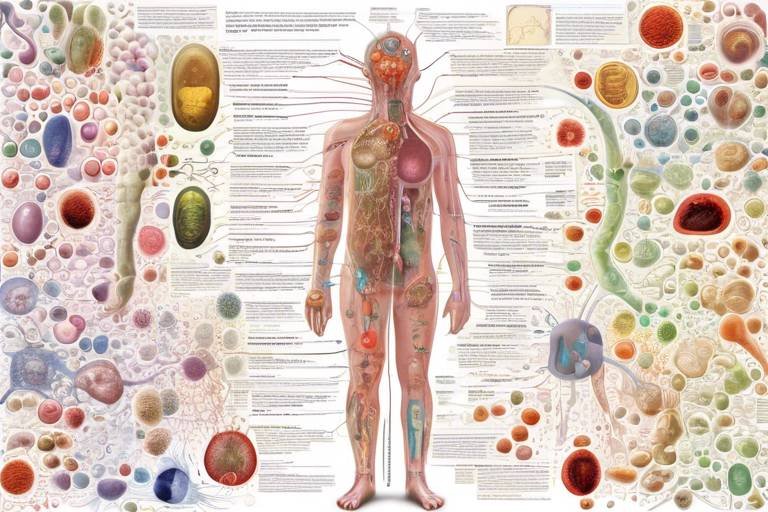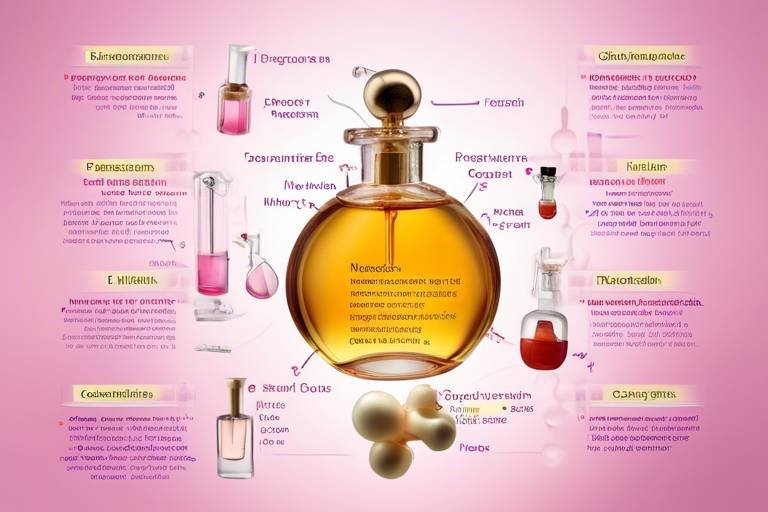The Biology of Taste Buds - How We Experience Flavor
Have you ever wondered why a ripe strawberry tastes so much better than a green one? Or why that bowl of soup seems bland without a dash of salt? The answer lies in the fascinating world of taste buds. These tiny sensory organs are not just responsible for detecting flavors; they play a crucial role in how we experience and enjoy food. In this article, we’ll dive deep into the structure and function of taste buds, explore the five basic tastes, and uncover how our olfactory system enhances our flavor perception.
Taste buds are specialized sensory organs located primarily on our tongues, but they can also be found in other areas of the mouth and throat. Each taste bud contains a cluster of taste receptor cells that are responsible for detecting different tastes. Imagine them as tiny sentinels, constantly on the lookout for flavors in the food we consume. These cells are equipped with microvilli, which are tiny hair-like structures that extend into the mouth's surface, allowing them to interact with the substances we eat. When food molecules dissolve in saliva, they stimulate these receptor cells, sending signals to our brain that translate into the sensations of taste.
Humans can perceive five basic tastes: sweet, sour, salty, bitter, and umami. Each of these tastes plays a unique role in our dietary choices and influences our overall food preferences. Let's break down the significance of each:
- Sweet: Often indicates energy-rich foods, like fruits and honey.
- Sour: Typically signals acidity, which can indicate spoilage in foods.
- Salty: Essential for maintaining electrolyte balance in our bodies.
- Bitter: Often a warning sign for toxicity in plants and foods.
- Umami: The savory taste that enhances the flavor of proteins and amino acids.
Each taste contributes to our overall experience of flavor, guiding our food choices and preferences. For instance, the sweetness of ripe fruit can evoke feelings of happiness and satisfaction, while the bitterness of certain greens may require an acquired taste.
Sweetness is perhaps the most celebrated of the five basic tastes. It indicates the presence of sugars and energy-rich foods, which are essential for our survival. But sweetness is more than just a flavor; it can trigger cravings and influence our dietary habits. Think about it: when you bite into a piece of chocolate cake, the rush of sweetness can create a moment of pure bliss. This craving for sweet flavors has deep evolutionary roots, as our ancestors sought out high-calorie foods to sustain their energy levels.
However, it’s important to recognize that not all sweetness is beneficial. The modern diet often includes excessive amounts of added sugars, leading to health issues like obesity and diabetes. Understanding this relationship helps us make better dietary choices. Moderation is key; while it’s okay to indulge in sweets occasionally, being mindful of our sugar intake is crucial for maintaining our overall health.
Interestingly, our preferences for sweetness can vary significantly across cultures. For instance, some cultures favor desserts that are extremely sweet, while others may prefer a more balanced flavor profile. This variation shapes culinary traditions and influences food choices around the world. It’s fascinating to see how our backgrounds can dictate what we find delicious!
Umami, often described as a savory taste, is essential for detecting amino acids and proteins. It’s what makes foods like tomatoes, mushrooms, and aged cheeses so irresistible. This taste is crucial in culinary practices, enhancing flavors and making dishes more satisfying. Think of umami as the secret ingredient that ties a meal together, elevating it from ordinary to extraordinary.
While taste buds are vital, they are not the only players in the flavor experience. The olfactory system significantly enhances our taste experience by contributing to flavor perception. When we eat, the aromas of our food travel through the nasal passages, combining with the taste detected by our taste buds to create complex flavor profiles. This interaction is why food can taste bland when we have a cold or a stuffy nose.
Understanding the connection between taste and smell is vital for appreciating food. The olfactory signals enhance flavor, and when these signals are disrupted, such as in cases of smell disorders, our enjoyment of food can diminish significantly. It’s a reminder of how interconnected our senses are, working together to create a rich tasting experience.
Temperature can also influence our perception of taste, altering flavors and intensities. For example, serving wine at the right temperature enhances its flavor profile, while cold foods can dull certain tastes. This section examines how serving temperatures affect our overall tasting experience and enjoyment of food, emphasizing that sometimes, it’s not just what we eat, but how we serve it that matters.
Advancements in taste research are uncovering new insights into how we perceive flavor. Emerging studies and technologies may revolutionize our understanding of taste and its implications for food science. As we explore this dynamic field, we may discover new ways to enhance flavors, reduce unhealthy ingredients, and even tailor foods to better suit our individual preferences.
- What are taste buds made of?
Taste buds consist of taste receptor cells, supporting cells, and basal cells, all working together to detect flavors. - Can taste buds regenerate?
Yes, taste buds can regenerate approximately every 10 to 14 days, which helps maintain our sense of taste. - Why do some people have different taste preferences?
Genetics, cultural background, and personal experiences can all influence individual taste preferences.

The Structure of Taste Buds
Taste buds are not just simple receptors; they are complex sensory organs that play a crucial role in how we experience flavor. Located primarily on the tongue, these tiny structures can also be found in other areas of the mouth and throat, including the soft palate and the epiglottis. Each taste bud contains between 50 to 150 taste receptor cells, which are responsible for detecting the various taste modalities. But how do these little wonders work?
Each taste bud is shaped somewhat like a tiny onion, with a rounded structure that houses the taste receptor cells. The outer layer of the taste bud features a small opening called the taste pore, which allows tastants—substances that can be tasted—to enter and interact with the receptor cells. When a tastant binds to a receptor, it triggers a cascade of biochemical reactions that send signals to the brain, allowing us to perceive different tastes.
Interestingly, taste buds are not static; they are constantly being renewed. The lifespan of a taste receptor cell is typically around 10 to 14 days. This regeneration process is essential because it ensures that our taste perception remains sharp and responsive to the myriad flavors we encounter in our diets. The turnover of these cells is a fascinating aspect of their biology, reflecting the dynamic nature of our sensory systems.
To give you a clearer picture, here's a simple table summarizing the key components of taste buds:
| Component | Description |
|---|---|
| Taste Receptor Cells | Specialized cells that detect tastes and send signals to the brain. |
| Taste Pore | The opening that allows tastants to enter the taste bud. |
| Supporting Cells | Cells that provide structural support and nourishment to taste receptor cells. |
| Basal Cells | Stem cells that can develop into new taste receptor cells. |
In addition to their physical structure, taste buds are also influenced by various factors, including age, health, and even genetics. For example, as we age, the number of taste buds can decrease, which may explain why older adults often have different taste preferences compared to younger individuals. Moreover, certain medical conditions or medications can affect taste perception, leading to alterations in how flavors are experienced.
Understanding the structure of taste buds not only sheds light on the mechanics of taste perception but also enhances our appreciation for the intricate processes that govern our culinary experiences. So, the next time you savor a delicious meal, take a moment to appreciate the remarkable biology working behind the scenes!

The Five Basic Tastes
The human palate is a remarkable system equipped to perceive a spectrum of flavors that greatly influences our eating habits and preferences. There are five basic tastes that our taste buds can detect: sweet, sour, salty, bitter, and umami. Each of these tastes plays a unique role in how we experience food and can evoke different emotions and memories. Understanding these tastes not only enhances our culinary experiences but also provides insight into our nutritional choices.
Let’s dive deeper into each of these tastes and explore their significance:
| Taste | Description | Examples |
|---|---|---|
| Sweet | Indicates the presence of sugars and energy-rich foods. | Fruits, candy, honey |
| Sour | Signals acidity, often associated with fermentation or ripeness. | Lemons, vinegar, yogurt |
| Salty | Enhances flavor and indicates the presence of sodium, essential for bodily functions. | Salted nuts, chips, soy sauce |
| Bitter | Often a warning sign for toxicity, but also contributes to complex flavors. | Dark chocolate, coffee, kale |
| Umami | Describes a savory taste, essential for detecting amino acids and proteins. | Meats, cheese, mushrooms |
Each taste not only adds to the flavor profile of our meals but also plays a crucial role in our evolution. For instance, sweetness generally indicates energy-rich foods, which would have been crucial for survival in our ancestral environments. On the other hand, bitterness often serves as a natural warning system, alerting us to potentially harmful substances. So, next time you savor a delicious dish, remember that your taste buds are not just enjoying flavors; they are engaging in a complex dialogue with your body, guiding you toward what is beneficial and away from what could be harmful.
Moreover, the interplay of these tastes can create a symphony of flavors in our meals. For example, the balance of salty and sweet can elevate a dish, making it more enjoyable and memorable. This is why chefs often experiment with contrasting flavors to surprise our palates and create culinary masterpieces. Think about the joy of biting into a salted caramel treat, where the sweetness of caramel meets the sharpness of salt, creating an explosion of flavor that dances on your taste buds.
In summary, the five basic tastes are fundamental to our experience of flavor and play vital roles in our dietary choices. They are not merely sensations; they are key players in the intricate game of survival, pleasure, and cultural expression. Understanding these tastes can enhance our appreciation for food and help us make more informed dietary choices.
- What are the five basic tastes? The five basic tastes are sweet, sour, salty, bitter, and umami.
- Why is umami important? Umami is essential for detecting proteins and amino acids, making it a crucial taste in many savory dishes.
- How do taste and smell work together? Taste and smell are interconnected; the olfactory system enhances flavor perception, allowing us to enjoy food more fully.
- Can taste preferences change over time? Yes, taste preferences can evolve due to cultural influences, exposure to different foods, and changes in our health.

The Role of Sweetness
Sweetness plays a pivotal role in our culinary experiences and dietary choices. It’s not just a delightful sensation on the tongue; it serves as an indicator of energy-rich foods. Think about it: when you bite into a ripe fruit or indulge in a piece of chocolate cake, the first thing that hits you is that glorious sweetness. This is your body’s way of saying, “Hey, this food is packed with energy!” In our evolutionary history, sweetness has been a survival signal. Early humans were naturally inclined to seek out sweet foods because they often signified safe, nutritious sources of energy.
But sweetness isn’t just about survival; it also influences our cravings and dietary habits. Have you ever noticed how a sugary treat can lift your mood? That’s because sweet foods often trigger the release of dopamine, the brain's feel-good chemical. This connection can lead to a cycle where we crave more sweet foods for that instant gratification. However, this can also create challenges, especially in a world where sugary snacks are abundant and often heavily marketed.
When we talk about sweetness, it’s essential to consider its impact on health. Excessive sugar consumption has been linked to various health issues, including obesity, diabetes, and even heart disease. The World Health Organization recommends that added sugars should make up less than 10% of our total daily caloric intake. Here’s a quick breakdown of how sugar can affect our health:
| Health Issue | Impact of Excessive Sugar |
|---|---|
| Obesity | Can lead to increased body fat and related health issues. |
| Diabetes | High sugar intake can lead to insulin resistance. |
| Heart Disease | Excess sugar can raise blood pressure and increase inflammation. |
Understanding the balance between enjoying sweetness and maintaining health is crucial. Moderation is key! It’s perfectly okay to enjoy that slice of cake or a scoop of ice cream, but being mindful of how often and how much we indulge can make a big difference in our overall health.
Culture also plays a significant role in our preferences for sweetness. Different regions around the globe have their unique takes on sweet flavors, often influenced by local ingredients and traditions. For instance, in some Asian cultures, desserts are typically less sweet than in Western countries. This cultural variation can shape our taste buds from a young age, leading to lifelong preferences. It’s fascinating to think about how our upbringing and environment can dictate our cravings for sweetness!
In summary, sweetness is more than just a flavor; it’s a complex interplay of biology, psychology, and culture. It influences our choices, our health, and even our happiness. So, the next time you enjoy something sweet, take a moment to appreciate all the layers of meaning behind that delightful taste!

Sweetness and Health
Sweetness is one of the most delightful sensations we can experience, often evoking feelings of joy and satisfaction. However, it’s important to recognize that our love for sweet flavors can have significant implications for our health. While natural sugars found in fruits and vegetables can provide essential nutrients and energy, excessive consumption of added sugars, commonly found in processed foods, can lead to a range of health issues.
Research has shown that diets high in sugar can contribute to serious conditions, including:
- Obesity: High sugar intake is linked to an increase in caloric consumption, leading to weight gain and obesity.
- Diabetes: Over time, excessive sugar can lead to insulin resistance, a major risk factor for type 2 diabetes.
- Heart Disease: A diet high in added sugars can elevate blood pressure and increase inflammation, contributing to heart disease.
Moreover, the World Health Organization (WHO) recommends that added sugars should make up less than 10% of our total daily caloric intake. This means being mindful about the foods we consume and understanding the hidden sugars in products we might not expect. For instance, many sauces, dressings, and even bread can contain surprising amounts of sugar.
To put this into perspective, let’s take a look at a comparison of sugar content in some common foods:
| Food Item | Sugar Content (grams per serving) |
|---|---|
| Soda (12 oz) | 39g |
| Fruit Yogurt (6 oz) | 26g |
| Granola Bar | 12g |
| Apple (medium) | 19g |
Interestingly, not all sweetness is created equal. Natural sugars found in whole foods come packaged with fiber, vitamins, and minerals, which help mitigate the negative effects of sugar. In contrast, processed sugars often lack these beneficial nutrients and can lead to quick spikes in blood sugar levels, followed by crashes that leave us craving more sugar. This cycle can create a dependency on sweet foods, making it challenging to break free from unhealthy eating habits.
In conclusion, while sweetness can enhance our culinary experiences, being aware of our sugar intake and making informed dietary choices is crucial for maintaining good health. Balancing our love for sweet flavors with a mindful approach to consumption can lead to a healthier lifestyle, allowing us to enjoy the pleasures of sweetness without the associated health risks.
- What are the health risks of consuming too much sugar? Excessive sugar consumption can lead to obesity, diabetes, and heart disease.
- How can I reduce sugar in my diet? Opt for whole foods, read nutrition labels, and replace sugary drinks with water or unsweetened beverages.
- Are natural sugars better than added sugars? Yes, natural sugars found in fruits and vegetables come with beneficial nutrients, unlike added sugars in processed foods.

Cultural Variations in Sweetness Preferences
When it comes to sweetness, culture plays a monumental role in shaping our preferences and culinary traditions. Different regions around the world have developed unique tastes that reflect their history, agriculture, and even climate. For instance, in many Western countries, there's a strong inclination towards sugary desserts, while in certain Asian cultures, the use of natural sweeteners like honey or palm sugar is more prevalent. This divergence can be traced back to the ingredients that are locally available and the traditional dishes that have been passed down through generations.
In countries like Japan, sweetness is often subtle and balanced, with desserts like mochi and dorayaki emphasizing natural flavors rather than overwhelming sugar. On the other hand, American desserts, such as cheesecakes and brownies, tend to be rich and indulgent, showcasing a love for bold sweetness. This difference in preference illustrates how cultural backgrounds can dictate not just what we eat, but how we perceive sweetness itself.
Moreover, the concept of sweetness can vary even within a single country. For example, in Italy, the traditional dessert tiramisu offers a rich coffee flavor balanced with just the right amount of sweetness, while in the southern United States, the famous pecan pie is unapologetically sweet, often topped with whipped cream or ice cream. These regional variations highlight the importance of local ingredients and the culinary practices that have evolved over time.
Interestingly, cultural attitudes towards sweetness also influence health perceptions. In some cultures, excessive sweetness is often viewed as indulgent and potentially harmful, leading to a more restrained approach to sweetening foods. In contrast, other cultures may embrace sweetness as a source of joy and celebration, integrating it into festive occasions and daily life. Understanding these cultural nuances not only enriches our culinary experiences but also offers insights into global dietary habits and health trends.
To illustrate these fascinating cultural differences in sweetness preferences, consider the following table:
| Region | Typical Sweet Ingredients | Common Desserts |
|---|---|---|
| North America | Refined sugar, corn syrup | Brownies, cheesecakes |
| Japan | Red bean paste, mochi | Mochi, dorayaki |
| Middle East | Honey, dates | Baklava, halva |
| Italy | Mascarpone, coffee | Tiramisu, panna cotta |
As we explore the world of sweetness, it becomes evident that our preferences are deeply rooted in cultural identity and tradition. The next time you indulge in a sweet treat, take a moment to consider how your cultural background might influence your taste. It's a delicious reminder of the diversity that exists in our culinary world!
Q: Why do different cultures have varying preferences for sweetness?
A: Cultural preferences for sweetness are influenced by local ingredients, historical dietary habits, and traditional culinary practices that have evolved over time.
Q: How does the perception of sweetness affect health?
A: In some cultures, excessive sweetness is viewed as unhealthy, leading to more restrained consumption, while others embrace it as a source of joy and celebration.
Q: Are there any health benefits associated with consuming sweet foods?
A: Moderation is key, but natural sweeteners like honey or fruits can provide energy and essential nutrients, contributing positively to a balanced diet.

The Importance of Umami
Umami, often referred to as the "fifth taste," plays a crucial role in our culinary experiences. It is a savory flavor that is primarily associated with the presence of amino acids, specifically glutamate, which is found in various foods such as meats, cheeses, and fermented products. But why is this taste so important? To understand its significance, we need to dive into its effects on our food choices and overall nutrition.
First off, umami enhances the flavor profile of dishes, making them more appealing and satisfying. When you bite into a perfectly cooked steak or savor a rich bowl of miso soup, the umami taste is what elevates that experience from ordinary to extraordinary. This taste not only makes food more enjoyable but also signals the presence of proteins, which are essential for our body's growth and repair. By appealing to our taste buds, umami encourages us to consume more protein-rich foods, which are vital for maintaining a balanced diet.
Interestingly, umami is not just about taste; it's also about the psychological aspect of eating. Foods rich in umami can evoke feelings of comfort and satisfaction, often reminding us of home-cooked meals or special occasions. This emotional connection to umami-rich foods can influence our eating habits, prompting us to seek out these flavors when we desire a comforting meal. In fact, many traditional cuisines around the world have mastered the art of umami, incorporating ingredients like soy sauce, tomatoes, and aged cheeses to create deep, rich flavors that resonate with our taste buds.
Moreover, as we explore the importance of umami, we can't overlook its role in health and nutrition. Research has shown that umami can enhance the palatability of low-sodium foods, making them more enjoyable without the need for excessive salt. This is particularly significant in today's world, where many individuals are looking to reduce sodium intake for better heart health. By incorporating umami-rich ingredients, we can create flavorful dishes that are not only tasty but also healthier.
To illustrate the impact of umami on our diet, consider the following table:
| Umami-Rich Foods | Benefits |
|---|---|
| Tomatoes | Rich in antioxidants, supports heart health |
| Cheese | Good source of calcium and protein |
| Mushrooms | Low in calories, high in nutrients |
| Seaweed | Rich in vitamins and minerals, supports thyroid function |
In conclusion, umami is more than just a taste; it is a complex flavor that enhances our eating experience, influences our dietary choices, and plays a significant role in our health. As we continue to explore the depths of flavor in our culinary adventures, it’s essential to appreciate the importance of umami and how it enriches our lives.
- What is umami? Umami is one of the five basic tastes, characterized by a savory flavor often associated with amino acids.
- Where can I find umami-rich foods? Common sources include meats, fish, tomatoes, mushrooms, and fermented products like soy sauce.
- How does umami affect health? It can enhance the flavor of low-sodium foods, making them more palatable and potentially supporting healthier eating habits.
- Is umami important in cooking? Yes, umami adds depth and richness to dishes, making them more enjoyable and satisfying.

The Role of Olfactory System in Taste
The olfactory system plays a crucial role in how we experience taste, transforming the simple act of eating into a rich and complex sensory adventure. While taste buds on our tongue can detect basic flavors like sweet, sour, salty, bitter, and umami, it's our sense of smell that truly enhances these flavors. Have you ever noticed how food seems to taste bland when you have a cold? That's because the olfactory receptors in our nose are temporarily out of commission, demonstrating just how intertwined these two senses are.
When we eat, volatile compounds from our food travel through the air and enter our nasal cavity, where they interact with olfactory receptors. This interaction sends signals to the brain, which then combines these olfactory signals with the taste detected by our taste buds. This collaboration allows us to perceive the full flavor profile of what we’re consuming. In fact, studies show that up to 80% of what we perceive as taste actually comes from our sense of smell!
To illustrate this connection, consider the following table that summarizes the contributions of taste and smell to flavor perception:
| Aspect | Taste | Smell |
|---|---|---|
| Basic Functions | Detects sweet, sour, salty, bitter, umami | Detects complex aromas and scents |
| Location | Tongue | Nasal cavity |
| Impact on Flavor | Provides basic flavor identification | Enhances and enriches flavor experience |
| Effect of Impairment | Limited flavor detection | Significantly reduced flavor perception |
This synergy between taste and smell is why certain foods can evoke strong memories or emotions. The aroma of freshly baked cookies, for instance, can transport you back to your grandmother’s kitchen, making the experience far more than just a simple snack. The olfactory system is also why we often prefer certain foods over others, as our individual experiences and associations with various smells shape our preferences.
Moreover, the impact of temperature on our olfactory perception cannot be overlooked. Hot foods tend to release more aromatic compounds, enhancing the olfactory experience. Ever wondered why a hot bowl of soup smells so much better than a cold one? The heat activates more of the volatile compounds, making the aroma more pronounced and inviting.
In conclusion, the olfactory system is not just an accessory to taste; it is a vital player in the grand orchestra of flavor perception. By understanding how these senses work together, we can appreciate the complexity of our culinary experiences and perhaps even enhance them. So, the next time you savor a delicious meal, take a moment to appreciate not just the taste but also the incredible role that smell plays in creating that delightful experience.
- How do taste and smell work together? Taste and smell combine to create the perception of flavor, with smell contributing significantly to our overall sensory experience.
- What happens to taste when you have a cold? A cold can impair your sense of smell, leading to a diminished ability to taste food, making it seem bland.
- Why do hot foods smell stronger? Heat releases more volatile compounds, enhancing the aroma and making the food smell more inviting.

Taste and Smell Connection
The connection between taste and smell is a fascinating aspect of how we perceive flavor. Imagine biting into a juicy strawberry. The sweetness you experience isn’t just a result of your taste buds; it’s a symphony of signals from both your taste and olfactory systems working in harmony. When you chew, tiny molecules are released, wafting up to your nasal passages, where your olfactory receptors eagerly await. This interaction is what creates the rich, layered experience of flavor that we often take for granted.
To put it simply, taste and smell are like two dance partners, each enhancing the other's performance. While taste buds can detect five basic flavors—sweet, sour, salty, bitter, and umami—smell contributes a myriad of aromatic compounds that can make a simple dish feel like a gourmet experience. In fact, research suggests that up to 80% of what we perceive as taste actually comes from our sense of smell. So, the next time you enjoy a meal, remember that your nose is just as important as your taste buds!
But what happens when our sense of smell is compromised? For those with conditions such as anosmia (the loss of smell), food can become bland and unappealing. Imagine eating a bowl of soup that lacks aroma; it may taste fine, but the experience is nowhere near as enjoyable. This highlights how intertwined these senses are, and why they are critical for our overall enjoyment of food.
Moreover, the connection between taste and smell can also explain why certain foods evoke strong memories and emotions. The scent of freshly baked cookies might transport you back to your grandmother's kitchen, triggering feelings of nostalgia and comfort. This emotional connection is a powerful aspect of our relationship with food, underscoring the importance of both taste and smell in our culinary experiences.
In summary, the intricate relationship between taste and smell enriches our eating experiences, making each bite a complex interplay of flavors and aromas. As we continue to explore this connection, we gain a deeper appreciation for the art of cooking and the science of flavor.
- How do taste and smell work together? Taste and smell collaborate to create the perception of flavor, with smell providing aromatic cues that enhance the basic tastes detected by the tongue.
- What happens if I lose my sense of smell? Losing your sense of smell can significantly dull your ability to taste, making food seem bland and less enjoyable.
- Can smell influence my appetite? Yes! Pleasant aromas can stimulate appetite and enhance the overall eating experience.

Impact of Temperature on Taste
Did you know that the temperature of your food can dramatically change how it tastes? It's true! The way we experience flavors is not just about the ingredients but also about their temperature. When food is served hot, it can release more aromatic compounds, enhancing the overall flavor profile. On the other hand, cold temperatures can dull certain tastes, making flavors less pronounced. Imagine biting into a perfectly warm slice of chocolate cake versus a chilled one; the warmth can elevate the sweetness and richness, creating a delightful experience that sends your taste buds into overdrive!
Temperature affects our taste buds in various ways. For instance, when food is heated, it can intensify the sweetness and umami flavors while suppressing bitterness. This is why a hot bowl of soup can taste more savory than its cold counterpart. Similarly, cold foods, like ice cream, can mask flavors, making them taste sweeter than they actually are. This phenomenon is often why we crave cold drinks on a hot day; the chill can amplify our enjoyment of sweet flavors, making them feel more refreshing.
Additionally, the serving temperature can alter the texture of food, which is another crucial aspect of flavor perception. For example, a hot, gooey pizza offers a completely different mouthfeel than a cold slice. The combination of warmth and texture can create a more satisfying eating experience. To illustrate this point, consider the following table that summarizes how temperature influences the perception of different taste profiles:
| Temperature | Effect on Taste | Example Foods |
|---|---|---|
| Hot | Enhances sweetness and umami; suppresses bitterness | Hot soup, warm pastries |
| Cold | Can dull flavors; enhances sweetness | Ice cream, chilled fruits |
It's fascinating how our brains interpret these signals. When we eat something hot, our sensory receptors react differently than when we eat something cold. This is why chefs often consider the temperature of food when creating dishes. They know that serving a dish at the right temperature can elevate the dining experience and make flavors pop. So, the next time you're enjoying a meal, take a moment to appreciate not just the ingredients but also the temperature at which they're served. It can make all the difference!
In conclusion, temperature plays a vital role in our taste experience, influencing how we perceive flavors and textures. Whether it's the comforting warmth of a bowl of soup or the refreshing chill of ice cream, understanding this relationship can enrich our culinary adventures. So, are you ready to experiment with temperature in your cooking? Your taste buds will thank you!
- How does temperature affect food flavor?
Temperature can enhance or dull flavors. Hot foods tend to emphasize sweetness and umami, while cold foods can mask flavors and make them taste sweeter.
- Why do we prefer cold drinks on hot days?
Cold drinks can enhance the perception of sweetness, making them feel more refreshing in hot weather.
- What is the ideal temperature for serving soup?
Soups are typically best served hot, as the heat can enhance the flavors and aromas.

The Future of Taste Research
As we dive into the future of taste research, it's essential to recognize that we are only scratching the surface of understanding how our taste buds and olfactory systems work together to create the rich tapestry of flavors we experience daily. Recent advancements in technology are paving the way for groundbreaking discoveries that could change our relationship with food and flavor. Imagine a world where we can manipulate taste perception through innovative methods, enhancing our culinary experiences in ways we never thought possible!
One exciting area of research is the exploration of genetic factors that influence taste sensitivity. Scientists are beginning to identify specific genes that can determine how we perceive different flavors. For instance, some individuals may have a heightened sensitivity to bitterness due to genetic variations, affecting their food preferences and dietary choices. This understanding could lead to personalized nutrition plans tailored to individual taste profiles, revolutionizing how we approach diets and health.
Moreover, the integration of artificial intelligence in taste research is opening up new avenues. AI algorithms can analyze vast amounts of data from taste tests and flavor profiles, helping researchers predict how certain combinations of ingredients might taste. This technology could assist chefs in creating innovative recipes that tantalize our taste buds and push the boundaries of traditional cuisine. Imagine being able to create the perfect dish by simply inputting ingredients into a program and letting it suggest the best flavor combinations!
Additionally, researchers are investigating the impact of virtual reality (VR) on taste perception. By immersing individuals in a virtual environment while they eat, scientists can assess how visual and auditory cues influence our taste experiences. This could lead to new dining concepts where the ambiance and sensory inputs are carefully curated to enhance flavor perception. Think about enjoying a meal in a serene forest setting, where the sights and sounds amplify the taste of your food!
Another fascinating aspect of future taste research is the study of microbiomes. Our gut health plays a crucial role in how we perceive flavors, and researchers are beginning to uncover the connection between our gut microbiota and taste preferences. By understanding how different bacteria affect our taste experiences, we could develop probiotic foods that not only improve gut health but also enhance flavor perception. This could lead to a new wave of functional foods designed to promote health while delighting our palates.
As we look ahead, it’s clear that the future of taste research holds immense potential. With ongoing studies and technological advancements, we are set to discover more about the intricate world of flavor and how it impacts our lives. The implications of these findings could extend beyond culinary applications, influencing areas such as nutrition, health, and even psychology.
- What are the main areas of focus in taste research today?
Researchers are focusing on genetic influences on taste, artificial intelligence for flavor prediction, the role of virtual reality in taste perception, and the impact of gut microbiomes on flavor experiences. - How might technology change the way we experience food?
Advancements in AI and virtual reality could lead to personalized dining experiences and innovative flavor combinations, enhancing our overall enjoyment of food. - Can taste research influence health and nutrition?
Yes, understanding individual taste preferences can lead to personalized nutrition plans and the development of functional foods that promote health.
Frequently Asked Questions
- What are taste buds and where are they located?
Taste buds are specialized sensory organs primarily found on the tongue, but they can also be located in other areas of the mouth and throat. These tiny structures contain taste receptor cells that help us perceive different flavors in the foods and drinks we consume.
- How many basic tastes can humans perceive?
Humans can perceive five basic tastes: sweet, sour, salty, bitter, and umami. Each of these tastes plays a crucial role in our dietary choices and influences our overall food preferences.
- What is the role of sweetness in our diet?
Sweetness signals the presence of sugars and energy-rich foods, often driving our cravings for certain items. It has been essential in human evolution, guiding us toward energy sources necessary for survival.
- How does excessive sugar consumption affect health?
Excessive sugar intake can lead to various health issues, including obesity and diabetes. Understanding this relationship is vital for making informed dietary choices and maintaining a balanced lifestyle.
- Do cultural backgrounds influence taste preferences?
Absolutely! Different cultures have unique preferences for sweetness and other tastes, which significantly shape culinary traditions and food choices. This cultural variation adds richness to our global food landscape.
- What is umami, and why is it important?
Umami is often described as a savory taste and is crucial for detecting amino acids and proteins in our food. This taste plays a significant role in culinary practices and contributes to the nutritional value of our meals.
- How does the olfactory system enhance our taste experience?
The olfactory system works closely with our taste buds to create complex flavor profiles. Smell significantly enhances our perception of taste, making it essential for fully appreciating the flavors in our food.
- What is the connection between taste and smell?
The connection between taste and smell is vital for flavor perception. When we eat, the aromas from our food travel to our olfactory receptors, enhancing our overall tasting experience. This is why food can taste bland when we have a cold and can't smell properly!
- Does temperature affect how we perceive taste?
Yes, temperature can significantly influence our perception of taste. Different serving temperatures can alter the intensity and flavor of foods, affecting our overall enjoyment and experience.
- What advancements are being made in taste research?
Advancements in taste research are uncovering new insights into how we perceive flavor. Emerging studies and technologies are revolutionizing our understanding of taste, which could have significant implications for food science and culinary innovation.



















